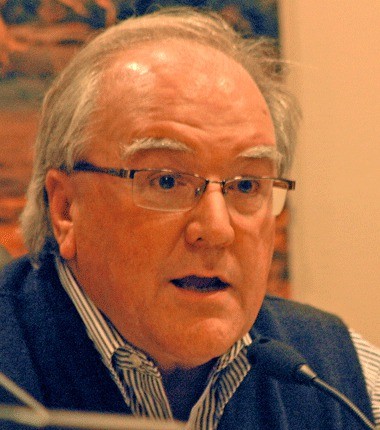You won’t find David Moseley pulling any punches when it come to Washington State Ferries or its financial future.
According to state Ferries’ assistant secretary, what lies ahead for the perennially cash-strapped agency is bleak, shaky and, he said, “… the sad fact remains, we’re not a sustainable system.”
In the meantime, however, Moseley said WSF has made “significant progress” in shoring up its bottom line through an assortment of cost-cutting moves. He prefaced a sort of State of the State Agency address by highlighting a handful of those spending reductions.
“We’ve been able to achieve $26 million in annual savings in administrative and capital spending,” Moseley said during a sparsely attended community meeting June 8 in Friday Harbor. “In the areas we control, we’re committed to managing costs as effectively as we can.”
He noted that WSF employees deserve credit for a large chunk of the drop in spending. The ferry system, like most state agencies, will see its payroll expenses drop due in part to a mandatory 3 percent reduction in state employee wages as called for under the state’s recently approved two-year budget, which goes into effect July 1 and includes roughly $5 billion in spending cuts overall.
In addition, WSF’s union workers have opted to forego $17 million in wage increases which had previously been approved as part of a recent collective bargaining agreement.
“Our employees recognize that we’re in a difficult financial position and have stepped up to be an important part of the solution,” Moseley said.
He said the ferry system is making steady progress in replacing its four 80-plus-year-old steel-electrics, which were pulled from the fleet four years ago, with three new boats, each with a capacity to carry 64 automobiles. Two have been built and construction of a third is ahead of schedule and expected to come in under budget, by about $5.5 million, when completed, he said.
And, he noted, all but one of the boats assigned to the San Juans’ routes are now sporting a fresh coat of “gleeming white” paint, and the last one in the queue, the Walla Walla, should be finished soon as well. That’s the good news.
The unsettling news, he noted, is that the forecast for state ferries, which is slated to receive infusion of $142 million in so-called “gas tax money” to help it remain afloat financially over the next two years, shows the agency running in the red by 2013.
Moseley said there will be no more gas-tax money to help bailout Ferries after the newly approved budget elapses in mid-2013.
“That’s what the governor means when she says there are no more band-aids in that box,” he said.
Moseley said that while additional funding enabled WSF to avoid potential cuts in service, the agency’s is tasked with raising $310 million in new revenue as part of 2011-2012 state budget. It’s banking on a 5.6 percent increase in fares — beginning with a 2.5 percent hike this year and the same amount the next — as well as a 25-cent surcharge on each ticket sold to help offset the rising cost of fuel.
“I don’t control the cost of fuel,” said Moseley, who noted the price of fuel now consumes nearly three times as much of WSF’s annual operating expenses as it did just a decade ago.
Ferries carried about 4 million fewer passengers last year as it did a decade ago as well. Though Ferries financial future may appear grim, Moseley said the governor recently created a bi-partisan blue-ribbon task force, which will include Sen. Mary Margret Haugen, D-Camano Island, chairwoman of the Senate Transporation Committee, to devise a comprehensive funding package that could finance the state’s future transportation needs and that would be put before the voters by 2012.
The governor insisted, he said, that whatever solution the task force may invent, “must deal with the structural financial problem of the state ferry system.”
Notebook: A proposed 2.5 percent fare hike and 25-cent fuel surcharge is slated to take effect later this year pending approval of the state Transporation Commission, which will meet in late August. … though thinly attended, state Ferries June 8 community meeting was broadcast in real-time via San Juan County’s website, and several viewers sent in questions via email which were fielded and responded to during the meeting by either Moseley or WSF staff.




